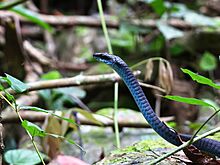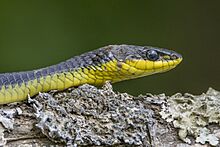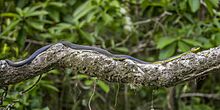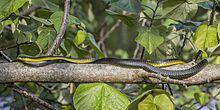Australian tree snake facts for kids
Quick facts for kids Dendrelaphis punctulatus |
|
|---|---|
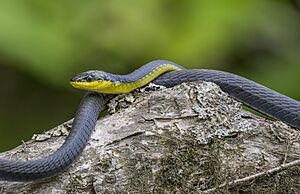 |
|
| Daintree River, Queensland, Australia | |
| Conservation status | |
| Scientific classification | |
| Genus: |
Dendrelaphis
|
| Species: |
punctulatus
|
| Synonyms | |
|
|
The Spotted Tree Snake (scientific name: Dendrelaphis punctulatus) is a fascinating reptile found in parts of Australia, Papua New Guinea, and some nearby islands. Imagine a snake that loves to climb trees, has beautiful colors, and is super quick! That's the Spotted Tree Snake. It's known for being very active during the day, often seen slithering through branches or basking in the sun.
These snakes are non-venomous, which means they are not dangerous to humans. They are also very important for their ecosystems, helping to control populations of frogs and lizards. They are often admired for their graceful movements and striking appearance.
Contents
What Does a Spotted Tree Snake Look Like?
Spotted Tree Snakes are known for their slender bodies and long tails, which help them balance and move easily through trees.
Colors and Patterns
One of the most interesting things about the Spotted Tree Snake is its color! While many people think of snakes as just green or brown, these snakes can be a rainbow of colors. They can be:
- Bright green
- Olive green
- Brown
- Copper
- Even black or yellow!
Sometimes, they have small, light-colored spots on their skin, which is how they got their name. Their belly is usually a lighter color, like cream or yellow. When they feel threatened, they can sometimes puff up their neck, showing off bright blue skin between their scales, which is a cool way to try and scare off predators!
Size and Shape
Spotted Tree Snakes are usually medium-sized. They can grow up to about 2 meters (6.5 feet) long, but most are a bit shorter, around 1.2 to 1.5 meters (4 to 5 feet). Their bodies are thin and streamlined, perfect for navigating dense foliage.
Where Does the Spotted Tree Snake Live?
These agile snakes are found in a variety of habitats across northern and eastern Australia, as well as Papua New Guinea and some Indonesian islands.
Preferred Habitats
Spotted Tree Snakes love places where they can climb and hide. You'll often find them in:
- Forests (especially rainforests and wet sclerophyll forests)
- Woodlands
- Shrublands
- Even suburban gardens, especially if there are lots of trees and shrubs!
They are very comfortable living near water sources like creeks and rivers, as these areas often have plenty of their favorite food.
Behavior
Unlike many snakes that are active at night, the Spotted Tree Snake is diurnal, meaning it's most active during the day. You might spot them:
- Basking in sunny spots on branches to warm up.
- Actively hunting for food among leaves and branches.
- Moving quickly through vegetation.
They are incredibly fast and agile, making them excellent hunters and escape artists.
How Does the Spotted Tree Snake Hunt?
The Spotted Tree Snake is a carnivore, meaning it eats other animals. It's a skilled hunter, using its speed and excellent eyesight to catch its prey.
These snakes are ambush predators, meaning they often wait patiently for prey to come close before striking quickly. Their camouflage helps them blend into their surroundings, making them almost invisible to unsuspecting prey. They use their keen eyesight to spot movement and their incredible speed to catch their meal.
What Do They Eat?
Their diet mainly consists of:
- Frogs
- Lizards (like geckos and skinks)
- Sometimes small birds or their eggs
They are not constrictors (meaning they don't squeeze their prey to death) and instead overpower their prey with their strong jaws and swallow them whole.
Is the Spotted Tree Snake Dangerous?
No, the Spotted Tree Snake is not venomous and is considered harmless to humans. If you encounter one, it's best to admire it from a distance and leave it alone. Like most wild animals, they prefer to be left undisturbed. If they feel threatened, they might try to escape quickly or, as mentioned, puff up their neck to look bigger and scarier.
Protecting the Spotted Tree Snake
While the Spotted Tree Snake is not currently considered endangered, it's important to protect their habitats. Losing forests and woodlands due to human development can affect their populations. By preserving natural areas and being mindful of wildlife, we can help ensure these beautiful snakes continue to thrive in their environments.
Gallery




